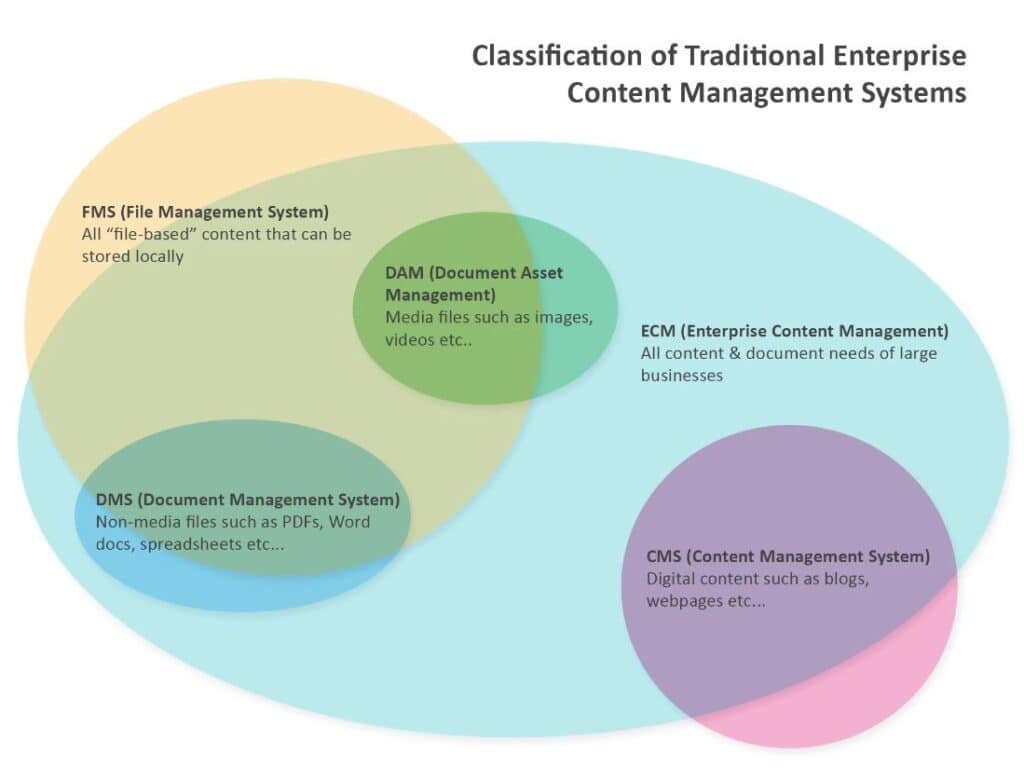How to Get Started with Digital Asset Management

Enterprise content management (ECM) is a broad category for all the activities of managing the lifecycle of the “content” that flows through your organization. This content comes in many different shapes and sizes: consumer data, contracts, logos, emails, ads, and more. Since your organization uses different types of content in different ways, you can use different ecosystems to manage that content. One of the most common types of ECM software is digital asset management.
Digital asset management gives organizations the tools to store, organize, use, and share assets like photos and videos. This guide will define digital asset management and walk through steps to help you get started with digital asset management.
Key Takeaways:
- Digital asset management is the component of enterprise content management that focuses on media files like images and videos.
- To start with digital asset management, first establish your goals, gather your assets, then structure and mitigate your data.
- FileCenter’s advanced document management tools can help you get the most value out of your documents.
Defining Digital Asset Management
Digital asset management (DAM), or alternatively, “document asset management,” primarily stores, organizes, and shares media-rich files such as pictures, GIFs, videos, but it can also include audio, music, and documents. Typically, DAM deals with files that require rights to use them.
Besides DAM, there are other types of ECM:
- Document management software (DMS): DMS deals primarily with text documents. DMS focuses on tools like text editing, e-signatures, optical character recognition, and file format conversion that help organizations manage, store, and share documents.
- Content management system (CMS): This helps organizations manage digital and web content. CMS typically focuses on two distinct components: a content management application (CMA) where users can create and modify web content, and a content delivery application (CDA) where users can compile those changes to the live website.
- File management system (FMS): This deals with the local storage of documents. FMS deals with the way you store files, while the other three deal with the way you use files, so your DAM might utilize FMS, or it might not, depending on the way you store documents.
These types of software aren’t individual storage silos — they’re tools for getting the most value out of different types of files, whether they’re media (images, videos), non-media (text, spreadsheets), or online digital content (blogs, emails).

3 Steps to Get Started with Digital Asset Management
Here are a few ways to start collaborating and sharing digital media assets with DAM:
1. Establish Goals
The overarching goal of DAM is to allow your organization to search, use, and share digital assets, but within that overall goal there’s some specific considerations you should keep in mind:
- Self-serviceability: One of the key strengths of digital asset management is that it gives users direct access to find and use the assets they’re looking for. Digital assets should be searchable and usable so that users can find assets on their own without a barrage of emails back and forth to your art or marketing department.
- Brand consistency: Your brand identity changes over time — even the most consistent materials still change over time. For example, American Airlines used the same logo from 1967 to 2013, a long 46 years. In that time, technology advanced and the way brands used their logos changed, so even though Massimo Vignelli’s iconic logo remained the same, American Airlines updated their logo to new digital formats, higher resolutions, and different applications.
- Metadata policy: “Data about data” or metadata primarily involves keyword tags that allow users to search for documents based on keywords, authorship, creation date, etc. In order for metadata to be truly useful, however, your users have to add consistent types of metadata to their digital assets. A metadata policy helps inform which types of tags you need for which types of assets.
2. Collect Assets for Your DAM
Once you’ve established your goals, begin collecting your digital assets. For a new company, this may just include a handful of logos and brochures, but for established businesses this can include thousands of assets spanning from webinars, portraits, sound effects, and 3D models.
In this step, you’re not only collecting the assets themselves, but also collecting the sources of assets. Your DAM is a collaborative environment, and in this step, you’re also identifying who within your company will be contributing assets as time goes on.

3. Prepare Structure and Migrate Content
One of the least glamorous but most important steps in getting started with digital asset management is to prepare the structure of your DAM. How many times have you been searching for a file, not knowing if it’s buried in a folder deep within your Documents, if it’s hiding in plain sight on your Desktop, or if it’s in another location altogether, like cloud storage or an external hard drive?
Your DAM should help solve that dilemma by structuring your storage in an intuitive, descriptive way. Combined with a consistent naming convention, this helps users quickly find and access the assets they’re looking for.
Once you’ve prepared the structure, you can begin migrating the assets you collected in step 2 into your DAM where users will be able to search, access, and share them.
Get Started with Document Management with FileCenter
Enterprise content management is a daunting task, but it doesn’t have to stay that way.
FileCenter is a full-featured document management software that helps users like you get the most out of their documents. With tools like automated routing, optical character recognition, and encrypted sharing portals, FileCenter gives you the power to get the most out of your documents.
Ready to upgrade your document management process? Download a free trial or get started today to see how FileCenter can help.


